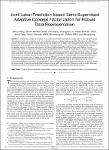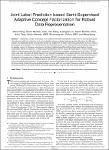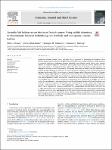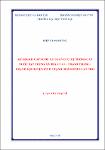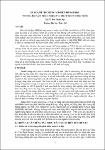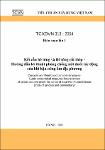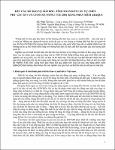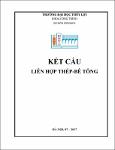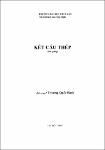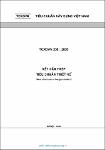- BB
Authors: Ye, Xinping; Advisor: -; Participants: - (2014) - Both habitat heterogeneity and species’ life-history traits play important roles in driving population dynamics, yet there is little scientific consensus around the combined effect of these two factors on populations in complex landscapes. Using a spatially explicit agent-based model, we explored how interactions between habitat spatial structure (defined here as the scale of spatial autocorrelation in habitat quality) and species life-history strategies (defined here by species environmental tolerance and movement capacity) affect population dynamics in spatially heterogeneous landscapes. We compared the responses of four hypothetical species with different life-history traits to fou...
|
- BB
Authors: Zhang, Zhao; Advisor: joint label prediction; Participants: Zhang, Yan; Liu, Guangcan; Tang, Jinhui; Shuicheng Yan; Wang, Meng (2019) - Constrained Concept Factorization (CCF) yields the enhanced representation ability over CF by incorporating label information as additional constraints, but it cannot classify and group unlabeled data appropriately. Minimizing the difference between the original data and its reconstruction directly can enable CCF to model a small noisy perturbation, but is not robust to gross sparse errors. Besides, CCF cannot preserve the manifold structures in new representation space explicitly, especially in an adaptive manner. In this paper, we propose a joint label prediction based Robust Semi-Supervised Adaptive Concept Factorization (RS2ACF) framework. To obtain robust representation, RS2ACF r...
|
- BB
Authors: Zhang, Zhao; Advisor: -; Participants: Zhang, Yan; Liu, Guangcan; Tang, Jinhui; Yan, Shuicheng; Wang, Meng (2019) - Constrained Concept Factorization (CCF) yields the enhanced representation ability over CF by incorporating label information as additional constraints, but it cannot classify and group unlabeled data appropriately. Minimizing the difference between the original data and its reconstruction directly can enable CCF to model a small noisy perturbation, but is not robust to gross sparse errors. Besides, CCF cannot preserve the manifold structures in new representation space explicitly, especially in an adaptive manner. In this paper, we propose a joint label prediction based Robust Semi-Supervised Adaptive Concept Factorization (RS2ACF) framework. To obtain robust representation, RS2ACF r...
|
- BB
Authors: Brown, Elliot J.; Advisor: -; Participants: Reis-Santos, Patrick; Gillanders, Bronwyn M.; Støttrup, Josianne G. (2019) - Connectivity between juvenile habitats and adult stocks is important for determining the resilience of local fisheries and the relative contribution of different juvenile habitat areas to adult populations. Otolith chemistry is commonly employed to differentiate between individuals from different juvenile habitat areas; whereby different environmental exposures, mediated by intrinsic physiological processes, produce different trace element concentrations in the biologically inert otolith. This study aims to determine if otolith chemistry can differentiate between juveniles of hybridising con-familials where they are found in the same habitat and to establish if otolith chemistry can e...
|
- LT
Authors: Sliuzas, R.V.; Advisor: -; Participants: - (2014) - This lecture presents: Floods in Kampala: all citizens are stakeholders; Kampala Capital City Authority and detailed study area; Kampala Rainfall data: filling the gaps; Soil property determination and mapping; Set of scenarios developed and discussed with stakeholders; Spatial visualization and indicators; Stakeholder engagement critical.
|
- BB
Authors: Osman, Samira A.; Advisor: -; Participants: Ali, Hoda B.; El-Ashry, Zeinab M.; El-Khodary, Soheir E. (2020) - From karyotype of studied Vicia species chromosomes, it was found that V. macrocarpa, V. sativa, and V. faba had six pairs of chromosome (2n = 12) while V. narbonensis and V. ervilia had seven pairs of chromosome (2n = 14). The most related species was found between V. ervilia and V. narbonensis (77.8%) depending on seed soluble protein similarity level, but between V. narbonensis and V. macrocarpa was 70.0% depending on seed non-soluble protein similarity level, while between V. ervilia and V. narbonensis, the most related species was 69.0% depending on collective data of both soluble and non-soluble seed storage protein.
|
- BB
Authors: Gärtner, N.; Advisor: -; Participants: Germann, L.; Wanyama, K.; Ouma, H.; Meierhofer, R. (2021) - In all three strategies, water at the kiosks was chlorinated to a free residual chlorine (FRC) concentration of 2 mg/L at the tap of the kiosk. In addition, water was collected in different containers for drinking water transport: a) uncleaned jerrycans, b) cleaned jerrycans, and c) cleaned improved containers with a wide mouth and a spigot. Water quality in the containers was compared to that of a control group collecting unchlorinated water in uncleaned jerrycans. Water samples were collected at the tap of the kiosk, from the containers of 135 households after they were filled at the tap, and from the same containers in the households after 24 h of water storage. The samples were an...
|
- BB
Authors: van Oudenhoven, A.P.E.; Advisor: -; Participants: Schröter, M.; Drakou, E.G. (2018) - We synthesized 16 criteria for ES indicator selection and organized them according to the widely used categories of credibility, salience, legitimacy (CSL). We propose to consider additional criteria related to feasibility (F), as CSL criteria alone often seem to produce indicators which are unachievable in practice. Considering CSLF together requires a combination of scientific knowledge, communication skills, policy and governance insights and on-field experience. In conclusion, we present a checklist to evaluate CSLF of your ES indicators. This checklist helps to detect and mitigate critical shortcomings in an early phase of the development process, and aids the development of effe...
|
- LA
Authors: Diệp, Thanh Hùng; Advisor: Võ, Anh Tuấn; Participants: - (2019) - Tổng quan về quản lý hệ thống cấp nước tại Việt Nam và trên thế giới. Hiện trạng khu vực cấp nước của trạm cấp nước tập trung xã Thạnh An, Thạnh Thắng, Thạnh Lợi - huyện Vĩnh Thạnh - thành phố Cần Thơ
|
- BB
Authors: Đào, Xuân Học; Advisor: -; Participants: - (2009) - Biến đổi khí hậu (BĐKH) trên phạm vi toàn cầu đã làm cho thiên tai ở Việt Nam ngày càng gia tăng về số lượng, cường độ và mức độ ảnh hưởng, ảnh hưởng rất lớn đến các hoạt động sản xuất, phát triển kinh tế xã hội. Lĩnh vực chịu tác động mạnh mẽ nhất do BĐKH là nông nghiệp, thuỷ lợi, thuỷ sản, diêm nghiệp, lâm nghiệp, an ninh lương thực; các vùng đồng bằng và dải ven biển do mực nước biển dâng, người nghèo ở vùng nông thôn, đòi hỏi chúng ta phải có chương trình, kế hoạch hành động cụ thể nhằm ứng phó kịp thời. Nhận thức rõ được tầm quan trọng, Bộ Nông nghiệp và PTNT đã sớm triển khai các chương trình, dự án nghiên cứu tác động của BĐKH, lồng ghép yếu tố BĐKH vào chiến lược và quy hoạch ...
|
- LT
Authors: Bộ môn Xây dựng dân dụng và Công nghiệp; Advisor: -; Participants: - (2020) - Nội dung bài giảng gồm: Chương I. Lý thuyết vỏ; Chương II: Mái vỏ trụ; Chương III: Bể chứa; Chương IV. Bunke và Silô; Chương V. Tường chắn đất bằng BTCT.
|
- QP
Authors: -; Advisor: -; Participants: - (2004) - -
|
- BB
Authors: Nguyễn, Đăng Hưng; Phan, Tấn Huy; Advisor: -; Participants: - (2011) - Nghiên cứu đề xuất và tính toán các kết cấu mới để bảo vệ bờ sông, bờ biển có khả năng thích ứng được các tác động ngày càng gia tăng của tự nhiên là một trong những đóng góp thiết thực vào các nghiên cứu trong lĩnh vực đê điều và bảo vệ bờ hiện nay. Các tác giả của bài báo giới thiệu tóm tắt quá trình phát triển kết cấu kè mảng mềm bằng các cấu kiện bê tông liên kết tự chèn và kết cấu chân kè HWRU-TOE-2001 đồng thời giới thiệu kết quả phân tích loại kết cấu này bằng phần mềm ABAQUS làm tài liệu tham khảo cho các nghiên cứu lựa chọn và thiết kế kết cấu kè bảo vệ mái dốc.
|
- LT
Authors: Bộ môn Xây dựng dân dụng và Công nghiệp; Advisor: -; Participants: - (2017) - Nội dung bài giảng bao gồm: Chương 1: Kết cấu liên hợp thép – bê tông, vật liệu sử dụng trong kết cấu liên hợp; Chương 2: Sàn liên hợp; Chương 3: Dầm liên hợp Thép - Bê tông ; Chương 4: Cột liên hợp thép – bê tông ; Chương 5: Các dạng sơ đồ kết cấu khung
|
- SH
Authors: Trương, Quốc Bình; Advisor: -; Participants: - (2009) - -
|
- -
Authors: Vũ Thành Hải; Advisor: -; Participants: Trương Quốc Bình; Vũ Hoàng Hưng (2006) - Trình bày những kiến thức cơ bản về: cơ sở thiết kế kết cấu thép, liên kết hàn, liên kết bu lông, dầm thép, cột, giàn thép, cửa van kèm theo phụ lục phần cuối
|
- QP
Authors: -; Advisor: -; Participants: - (2005) - -
|
- LT
Authors: Bộ môn Xây dựng dân dụng và Công nghiệp; Advisor: -; Participants: - (2021) - Nội dung bài giảng: Chương 1: Kết cấu thép bản; Chương 2: Kết cấu thép công trình tháp và trụ; Chương 3: Kết cấu thép ứng suất trước
|
- LT
Authors: Đặng Ngọc Duyên; Advisor: -; Participants: - (2020) - Giới thiệu chung về cấu tạo và các phương án kết cấu, tính toán thiết kế ô tô cụ thể gồm: bộ li hợp, hộp số, truyền động các đăng, cầu chủ động của ô tô, khung xe và cầu điều khiển, hệ thống treo, hệ thống lái, phanh, vỏ xe, cabin, thùng xe
|
- BB
Authors: Lê Viết Hải; Advisor: -; Participants: Trần Quang Bình; Nguyễn Thị Quỳnh Hoa; Đoàn Lê Hoàng Tấn; Cổ Thanh Thiện; Trần Văn Mẫu (2018) - Kết quả nghiên cứu cho thấy Ag chiếm 2% khối lượng và có tác động tăng cường hoạt tính xúc tác của vật liệu composite đối với phản ứng phân tách nước tạo H2. Mật độ dòng sinh khí H2 ở quá thế8 50mV/RHE của vật liệu Ag@Zr-CPEB tăng 2,5 lần so với vật liệu nền Zr-CPEB.
|


